Exploring Financial Reporting Regulations in Australia and the UK
VerifiedAdded on 2023/06/12
|11
|3226
|218
Literature Review
AI Summary
This literature review examines the financial reporting regulatory environments of Australia and the United Kingdom, focusing on perceived problems, the functioning of the regulatory environment, and progress toward IFRS adoption. In Australia, the AASB operates under government regulations, aligning with IFRS standards but with some modifications. Challenges include a lack of training and difficulties for entities familiar with previous standards. In the UK, delays in IFRS adoption and sluggish endorsement processes are major concerns, with the EFRAG identifying early issues in new standard adoption. The analysis extends to the Regulatory Capture Theory, identifying small businesses in Australia as potential victims and highlighting the Competition Act and Enterprise Act in the UK as measures against monopoly power. The review concludes by emphasizing the importance of understanding these regulatory dynamics for effective financial reporting.
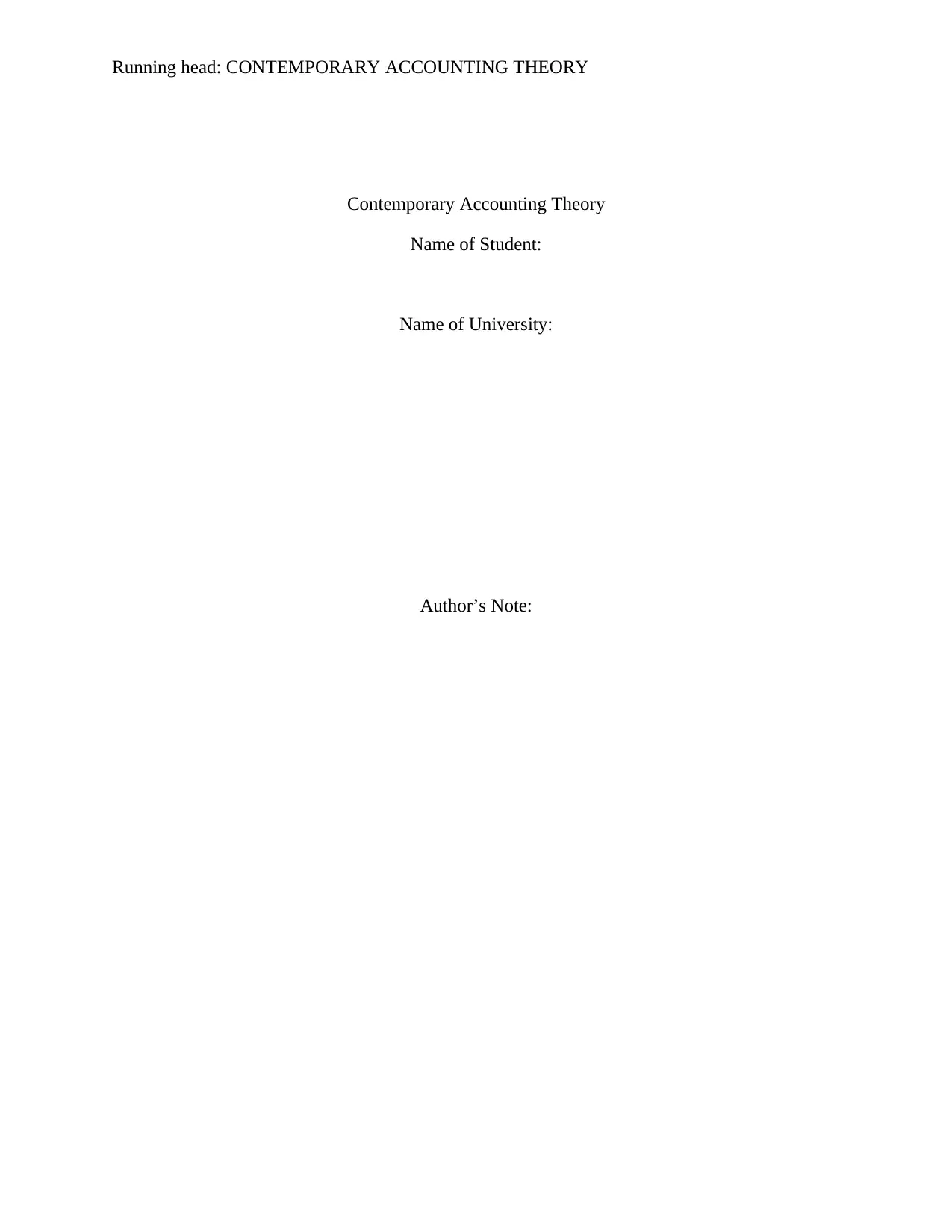
Running head: CONTEMPORARY ACCOUNTING THEORY
Contemporary Accounting Theory
Name of Student:
Name of University:
Author’s Note:
Contemporary Accounting Theory
Name of Student:
Name of University:
Author’s Note:
Paraphrase This Document
Need a fresh take? Get an instant paraphrase of this document with our AI Paraphraser
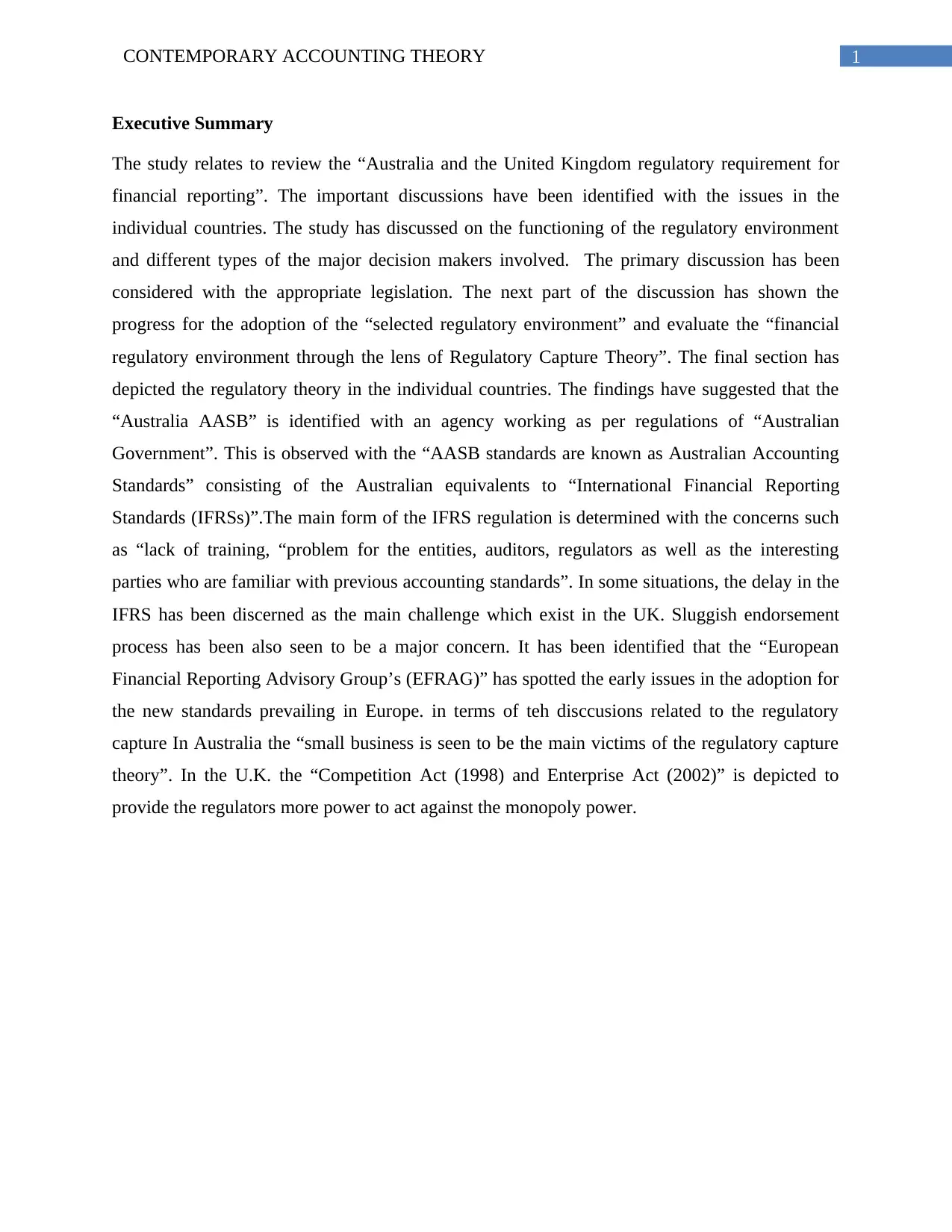
1CONTEMPORARY ACCOUNTING THEORY
Executive Summary
The study relates to review the “Australia and the United Kingdom regulatory requirement for
financial reporting”. The important discussions have been identified with the issues in the
individual countries. The study has discussed on the functioning of the regulatory environment
and different types of the major decision makers involved. The primary discussion has been
considered with the appropriate legislation. The next part of the discussion has shown the
progress for the adoption of the “selected regulatory environment” and evaluate the “financial
regulatory environment through the lens of Regulatory Capture Theory”. The final section has
depicted the regulatory theory in the individual countries. The findings have suggested that the
“Australia AASB” is identified with an agency working as per regulations of “Australian
Government”. This is observed with the “AASB standards are known as Australian Accounting
Standards” consisting of the Australian equivalents to “International Financial Reporting
Standards (IFRSs)”.The main form of the IFRS regulation is determined with the concerns such
as “lack of training, “problem for the entities, auditors, regulators as well as the interesting
parties who are familiar with previous accounting standards”. In some situations, the delay in the
IFRS has been discerned as the main challenge which exist in the UK. Sluggish endorsement
process has been also seen to be a major concern. It has been identified that the “European
Financial Reporting Advisory Group’s (EFRAG)” has spotted the early issues in the adoption for
the new standards prevailing in Europe. in terms of teh disccusions related to the regulatory
capture In Australia the “small business is seen to be the main victims of the regulatory capture
theory”. In the U.K. the “Competition Act (1998) and Enterprise Act (2002)” is depicted to
provide the regulators more power to act against the monopoly power.
Executive Summary
The study relates to review the “Australia and the United Kingdom regulatory requirement for
financial reporting”. The important discussions have been identified with the issues in the
individual countries. The study has discussed on the functioning of the regulatory environment
and different types of the major decision makers involved. The primary discussion has been
considered with the appropriate legislation. The next part of the discussion has shown the
progress for the adoption of the “selected regulatory environment” and evaluate the “financial
regulatory environment through the lens of Regulatory Capture Theory”. The final section has
depicted the regulatory theory in the individual countries. The findings have suggested that the
“Australia AASB” is identified with an agency working as per regulations of “Australian
Government”. This is observed with the “AASB standards are known as Australian Accounting
Standards” consisting of the Australian equivalents to “International Financial Reporting
Standards (IFRSs)”.The main form of the IFRS regulation is determined with the concerns such
as “lack of training, “problem for the entities, auditors, regulators as well as the interesting
parties who are familiar with previous accounting standards”. In some situations, the delay in the
IFRS has been discerned as the main challenge which exist in the UK. Sluggish endorsement
process has been also seen to be a major concern. It has been identified that the “European
Financial Reporting Advisory Group’s (EFRAG)” has spotted the early issues in the adoption for
the new standards prevailing in Europe. in terms of teh disccusions related to the regulatory
capture In Australia the “small business is seen to be the main victims of the regulatory capture
theory”. In the U.K. the “Competition Act (1998) and Enterprise Act (2002)” is depicted to
provide the regulators more power to act against the monopoly power.
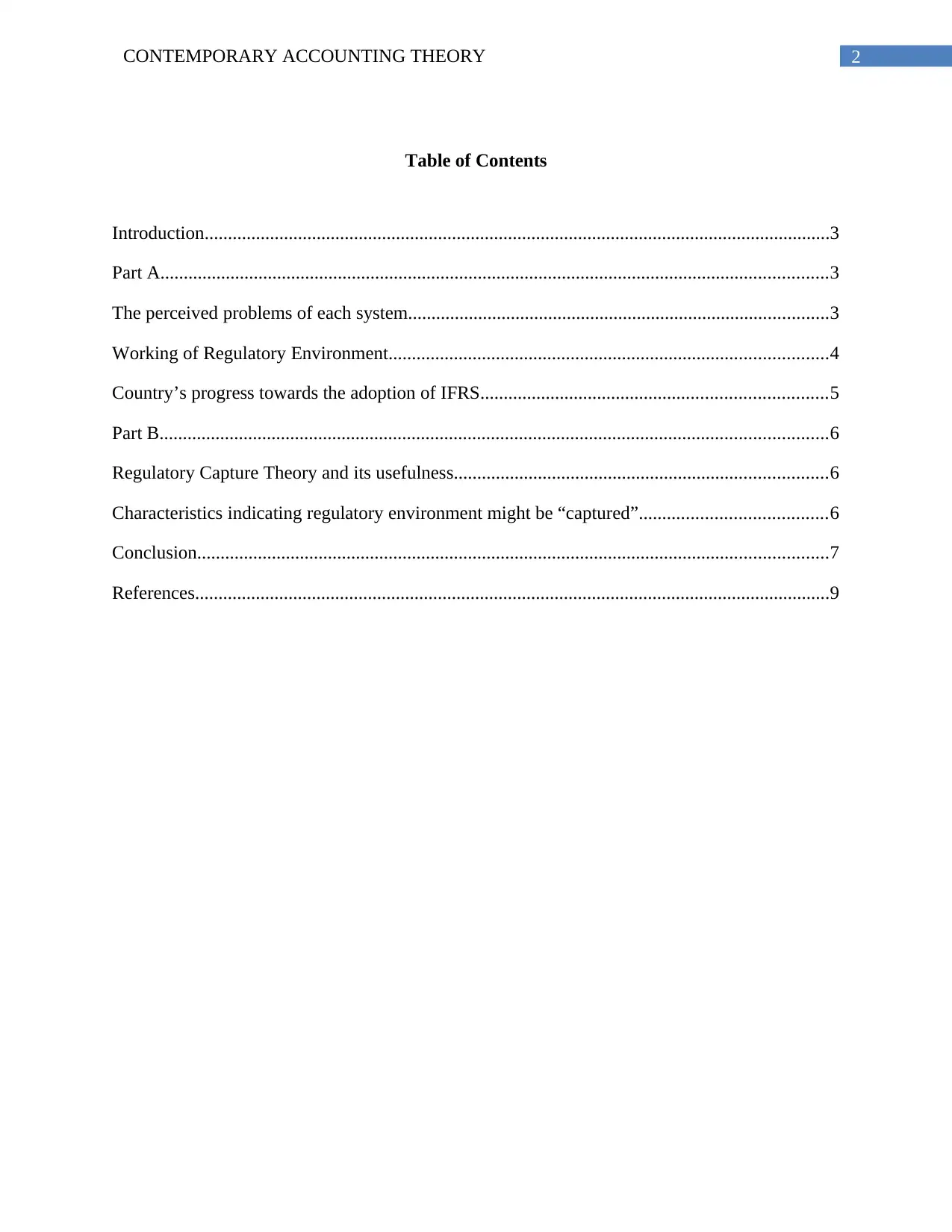
2CONTEMPORARY ACCOUNTING THEORY
Table of Contents
Introduction......................................................................................................................................3
Part A...............................................................................................................................................3
The perceived problems of each system..........................................................................................3
Working of Regulatory Environment..............................................................................................4
Country’s progress towards the adoption of IFRS..........................................................................5
Part B...............................................................................................................................................6
Regulatory Capture Theory and its usefulness................................................................................6
Characteristics indicating regulatory environment might be “captured”........................................6
Conclusion.......................................................................................................................................7
References........................................................................................................................................9
Table of Contents
Introduction......................................................................................................................................3
Part A...............................................................................................................................................3
The perceived problems of each system..........................................................................................3
Working of Regulatory Environment..............................................................................................4
Country’s progress towards the adoption of IFRS..........................................................................5
Part B...............................................................................................................................................6
Regulatory Capture Theory and its usefulness................................................................................6
Characteristics indicating regulatory environment might be “captured”........................................6
Conclusion.......................................................................................................................................7
References........................................................................................................................................9
⊘ This is a preview!⊘
Do you want full access?
Subscribe today to unlock all pages.

Trusted by 1+ million students worldwide
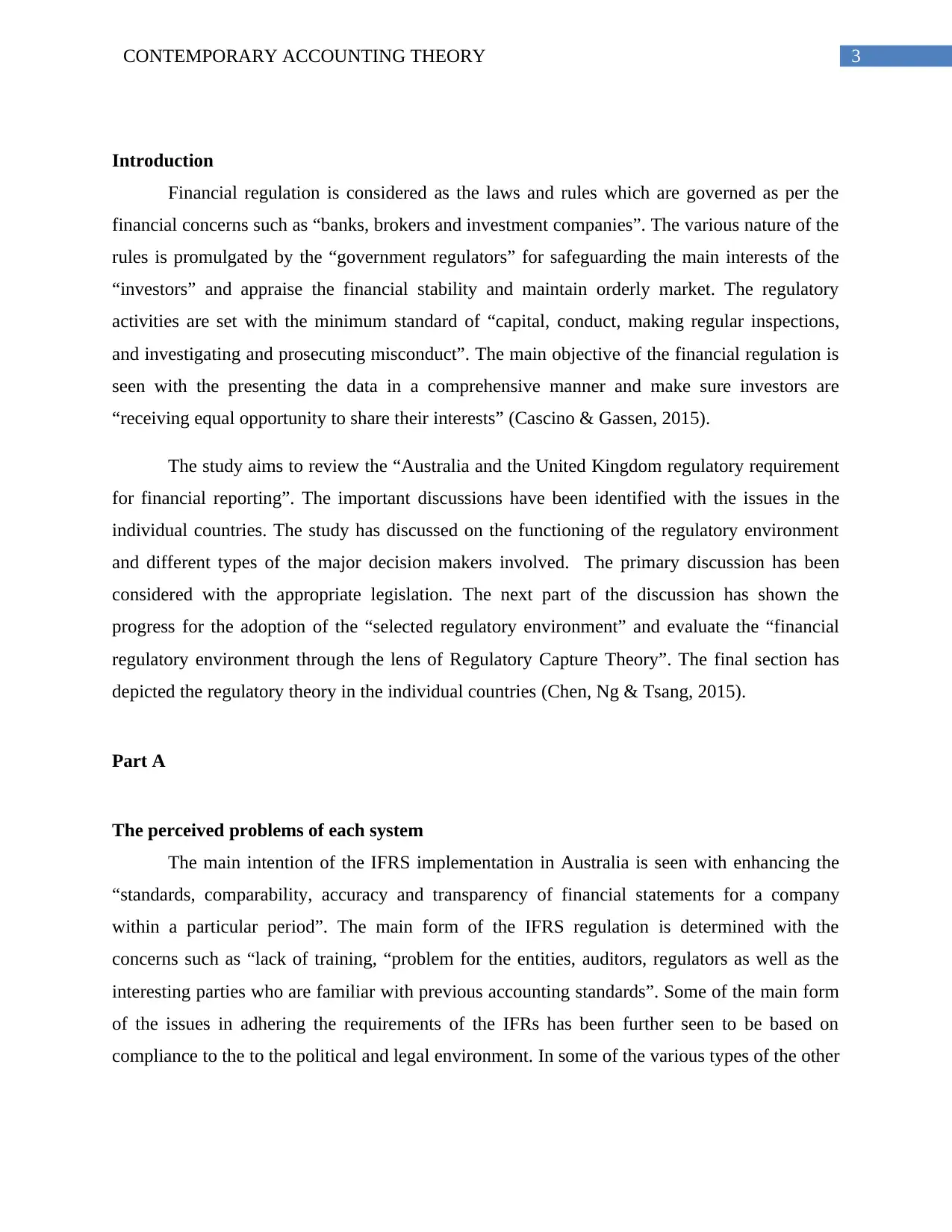
3CONTEMPORARY ACCOUNTING THEORY
Introduction
Financial regulation is considered as the laws and rules which are governed as per the
financial concerns such as “banks, brokers and investment companies”. The various nature of the
rules is promulgated by the “government regulators” for safeguarding the main interests of the
“investors” and appraise the financial stability and maintain orderly market. The regulatory
activities are set with the minimum standard of “capital, conduct, making regular inspections,
and investigating and prosecuting misconduct”. The main objective of the financial regulation is
seen with the presenting the data in a comprehensive manner and make sure investors are
“receiving equal opportunity to share their interests” (Cascino & Gassen, 2015).
The study aims to review the “Australia and the United Kingdom regulatory requirement
for financial reporting”. The important discussions have been identified with the issues in the
individual countries. The study has discussed on the functioning of the regulatory environment
and different types of the major decision makers involved. The primary discussion has been
considered with the appropriate legislation. The next part of the discussion has shown the
progress for the adoption of the “selected regulatory environment” and evaluate the “financial
regulatory environment through the lens of Regulatory Capture Theory”. The final section has
depicted the regulatory theory in the individual countries (Chen, Ng & Tsang, 2015).
Part A
The perceived problems of each system
The main intention of the IFRS implementation in Australia is seen with enhancing the
“standards, comparability, accuracy and transparency of financial statements for a company
within a particular period”. The main form of the IFRS regulation is determined with the
concerns such as “lack of training, “problem for the entities, auditors, regulators as well as the
interesting parties who are familiar with previous accounting standards”. Some of the main form
of the issues in adhering the requirements of the IFRs has been further seen to be based on
compliance to the to the political and legal environment. In some of the various types of the other
Introduction
Financial regulation is considered as the laws and rules which are governed as per the
financial concerns such as “banks, brokers and investment companies”. The various nature of the
rules is promulgated by the “government regulators” for safeguarding the main interests of the
“investors” and appraise the financial stability and maintain orderly market. The regulatory
activities are set with the minimum standard of “capital, conduct, making regular inspections,
and investigating and prosecuting misconduct”. The main objective of the financial regulation is
seen with the presenting the data in a comprehensive manner and make sure investors are
“receiving equal opportunity to share their interests” (Cascino & Gassen, 2015).
The study aims to review the “Australia and the United Kingdom regulatory requirement
for financial reporting”. The important discussions have been identified with the issues in the
individual countries. The study has discussed on the functioning of the regulatory environment
and different types of the major decision makers involved. The primary discussion has been
considered with the appropriate legislation. The next part of the discussion has shown the
progress for the adoption of the “selected regulatory environment” and evaluate the “financial
regulatory environment through the lens of Regulatory Capture Theory”. The final section has
depicted the regulatory theory in the individual countries (Chen, Ng & Tsang, 2015).
Part A
The perceived problems of each system
The main intention of the IFRS implementation in Australia is seen with enhancing the
“standards, comparability, accuracy and transparency of financial statements for a company
within a particular period”. The main form of the IFRS regulation is determined with the
concerns such as “lack of training, “problem for the entities, auditors, regulators as well as the
interesting parties who are familiar with previous accounting standards”. Some of the main form
of the issues in adhering the requirements of the IFRs has been further seen to be based on
compliance to the to the political and legal environment. In some of the various types of the other
Paraphrase This Document
Need a fresh take? Get an instant paraphrase of this document with our AI Paraphraser
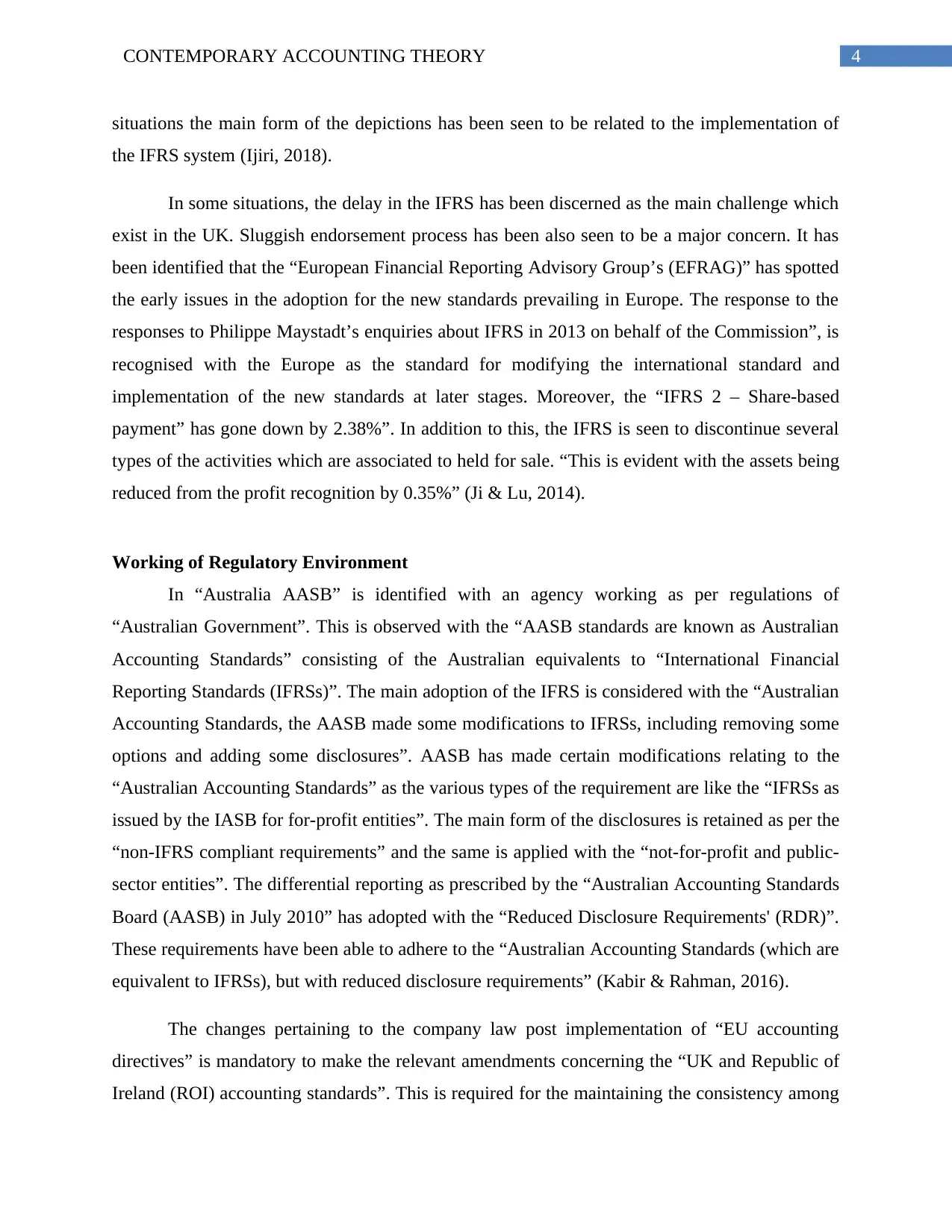
4CONTEMPORARY ACCOUNTING THEORY
situations the main form of the depictions has been seen to be related to the implementation of
the IFRS system (Ijiri, 2018).
In some situations, the delay in the IFRS has been discerned as the main challenge which
exist in the UK. Sluggish endorsement process has been also seen to be a major concern. It has
been identified that the “European Financial Reporting Advisory Group’s (EFRAG)” has spotted
the early issues in the adoption for the new standards prevailing in Europe. The response to the
responses to Philippe Maystadt’s enquiries about IFRS in 2013 on behalf of the Commission”, is
recognised with the Europe as the standard for modifying the international standard and
implementation of the new standards at later stages. Moreover, the “IFRS 2 – Share-based
payment” has gone down by 2.38%”. In addition to this, the IFRS is seen to discontinue several
types of the activities which are associated to held for sale. “This is evident with the assets being
reduced from the profit recognition by 0.35%” (Ji & Lu, 2014).
Working of Regulatory Environment
In “Australia AASB” is identified with an agency working as per regulations of
“Australian Government”. This is observed with the “AASB standards are known as Australian
Accounting Standards” consisting of the Australian equivalents to “International Financial
Reporting Standards (IFRSs)”. The main adoption of the IFRS is considered with the “Australian
Accounting Standards, the AASB made some modifications to IFRSs, including removing some
options and adding some disclosures”. AASB has made certain modifications relating to the
“Australian Accounting Standards” as the various types of the requirement are like the “IFRSs as
issued by the IASB for for-profit entities”. The main form of the disclosures is retained as per the
“non-IFRS compliant requirements” and the same is applied with the “not-for-profit and public-
sector entities”. The differential reporting as prescribed by the “Australian Accounting Standards
Board (AASB) in July 2010” has adopted with the “Reduced Disclosure Requirements' (RDR)”.
These requirements have been able to adhere to the “Australian Accounting Standards (which are
equivalent to IFRSs), but with reduced disclosure requirements” (Kabir & Rahman, 2016).
The changes pertaining to the company law post implementation of “EU accounting
directives” is mandatory to make the relevant amendments concerning the “UK and Republic of
Ireland (ROI) accounting standards”. This is required for the maintaining the consistency among
situations the main form of the depictions has been seen to be related to the implementation of
the IFRS system (Ijiri, 2018).
In some situations, the delay in the IFRS has been discerned as the main challenge which
exist in the UK. Sluggish endorsement process has been also seen to be a major concern. It has
been identified that the “European Financial Reporting Advisory Group’s (EFRAG)” has spotted
the early issues in the adoption for the new standards prevailing in Europe. The response to the
responses to Philippe Maystadt’s enquiries about IFRS in 2013 on behalf of the Commission”, is
recognised with the Europe as the standard for modifying the international standard and
implementation of the new standards at later stages. Moreover, the “IFRS 2 – Share-based
payment” has gone down by 2.38%”. In addition to this, the IFRS is seen to discontinue several
types of the activities which are associated to held for sale. “This is evident with the assets being
reduced from the profit recognition by 0.35%” (Ji & Lu, 2014).
Working of Regulatory Environment
In “Australia AASB” is identified with an agency working as per regulations of
“Australian Government”. This is observed with the “AASB standards are known as Australian
Accounting Standards” consisting of the Australian equivalents to “International Financial
Reporting Standards (IFRSs)”. The main adoption of the IFRS is considered with the “Australian
Accounting Standards, the AASB made some modifications to IFRSs, including removing some
options and adding some disclosures”. AASB has made certain modifications relating to the
“Australian Accounting Standards” as the various types of the requirement are like the “IFRSs as
issued by the IASB for for-profit entities”. The main form of the disclosures is retained as per the
“non-IFRS compliant requirements” and the same is applied with the “not-for-profit and public-
sector entities”. The differential reporting as prescribed by the “Australian Accounting Standards
Board (AASB) in July 2010” has adopted with the “Reduced Disclosure Requirements' (RDR)”.
These requirements have been able to adhere to the “Australian Accounting Standards (which are
equivalent to IFRSs), but with reduced disclosure requirements” (Kabir & Rahman, 2016).
The changes pertaining to the company law post implementation of “EU accounting
directives” is mandatory to make the relevant amendments concerning the “UK and Republic of
Ireland (ROI) accounting standards”. This is required for the maintaining the consistency among
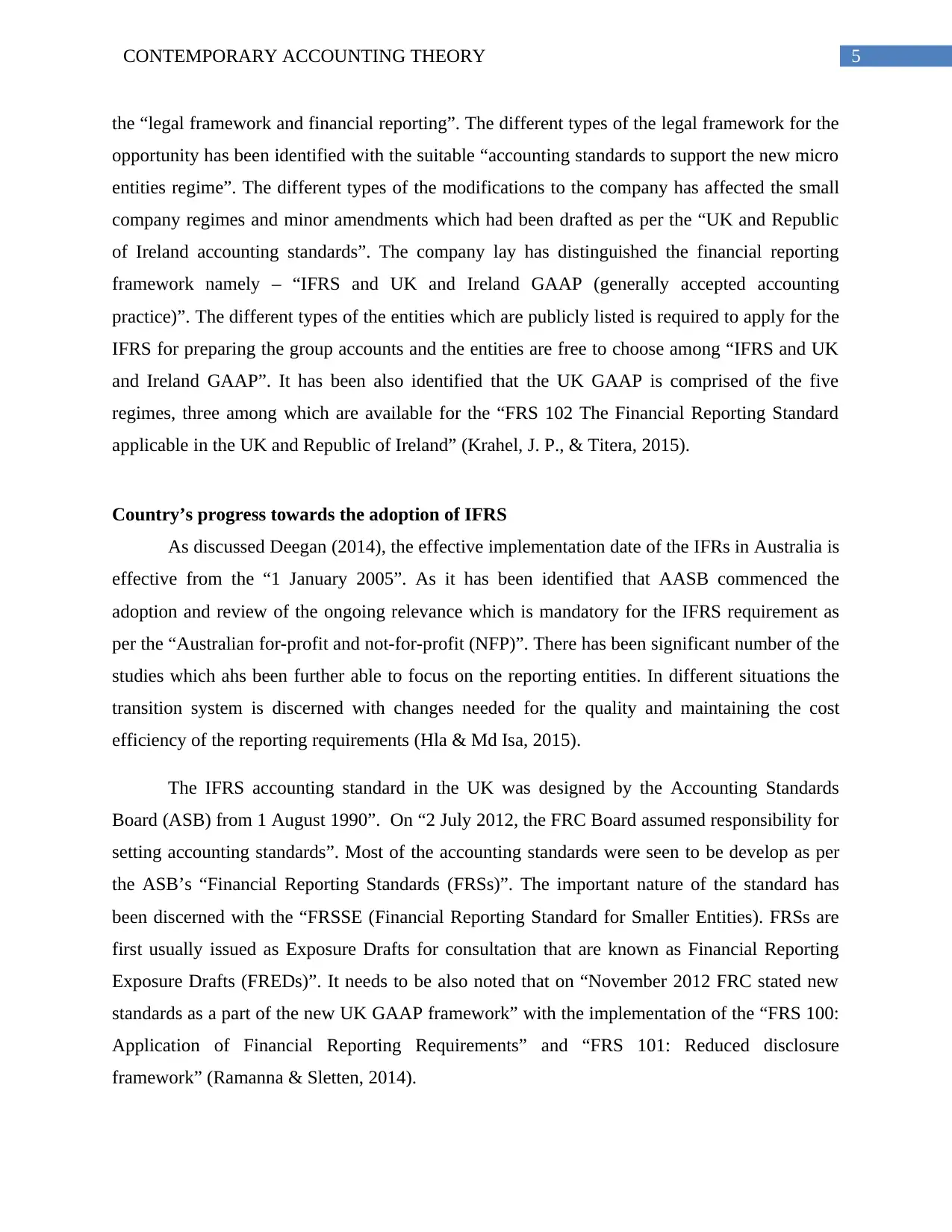
5CONTEMPORARY ACCOUNTING THEORY
the “legal framework and financial reporting”. The different types of the legal framework for the
opportunity has been identified with the suitable “accounting standards to support the new micro
entities regime”. The different types of the modifications to the company has affected the small
company regimes and minor amendments which had been drafted as per the “UK and Republic
of Ireland accounting standards”. The company lay has distinguished the financial reporting
framework namely – “IFRS and UK and Ireland GAAP (generally accepted accounting
practice)”. The different types of the entities which are publicly listed is required to apply for the
IFRS for preparing the group accounts and the entities are free to choose among “IFRS and UK
and Ireland GAAP”. It has been also identified that the UK GAAP is comprised of the five
regimes, three among which are available for the “FRS 102 The Financial Reporting Standard
applicable in the UK and Republic of Ireland” (Krahel, J. P., & Titera, 2015).
Country’s progress towards the adoption of IFRS
As discussed Deegan (2014), the effective implementation date of the IFRs in Australia is
effective from the “1 January 2005”. As it has been identified that AASB commenced the
adoption and review of the ongoing relevance which is mandatory for the IFRS requirement as
per the “Australian for-profit and not-for-profit (NFP)”. There has been significant number of the
studies which ahs been further able to focus on the reporting entities. In different situations the
transition system is discerned with changes needed for the quality and maintaining the cost
efficiency of the reporting requirements (Hla & Md Isa, 2015).
The IFRS accounting standard in the UK was designed by the Accounting Standards
Board (ASB) from 1 August 1990”. On “2 July 2012, the FRC Board assumed responsibility for
setting accounting standards”. Most of the accounting standards were seen to be develop as per
the ASB’s “Financial Reporting Standards (FRSs)”. The important nature of the standard has
been discerned with the “FRSSE (Financial Reporting Standard for Smaller Entities). FRSs are
first usually issued as Exposure Drafts for consultation that are known as Financial Reporting
Exposure Drafts (FREDs)”. It needs to be also noted that on “November 2012 FRC stated new
standards as a part of the new UK GAAP framework” with the implementation of the “FRS 100:
Application of Financial Reporting Requirements” and “FRS 101: Reduced disclosure
framework” (Ramanna & Sletten, 2014).
the “legal framework and financial reporting”. The different types of the legal framework for the
opportunity has been identified with the suitable “accounting standards to support the new micro
entities regime”. The different types of the modifications to the company has affected the small
company regimes and minor amendments which had been drafted as per the “UK and Republic
of Ireland accounting standards”. The company lay has distinguished the financial reporting
framework namely – “IFRS and UK and Ireland GAAP (generally accepted accounting
practice)”. The different types of the entities which are publicly listed is required to apply for the
IFRS for preparing the group accounts and the entities are free to choose among “IFRS and UK
and Ireland GAAP”. It has been also identified that the UK GAAP is comprised of the five
regimes, three among which are available for the “FRS 102 The Financial Reporting Standard
applicable in the UK and Republic of Ireland” (Krahel, J. P., & Titera, 2015).
Country’s progress towards the adoption of IFRS
As discussed Deegan (2014), the effective implementation date of the IFRs in Australia is
effective from the “1 January 2005”. As it has been identified that AASB commenced the
adoption and review of the ongoing relevance which is mandatory for the IFRS requirement as
per the “Australian for-profit and not-for-profit (NFP)”. There has been significant number of the
studies which ahs been further able to focus on the reporting entities. In different situations the
transition system is discerned with changes needed for the quality and maintaining the cost
efficiency of the reporting requirements (Hla & Md Isa, 2015).
The IFRS accounting standard in the UK was designed by the Accounting Standards
Board (ASB) from 1 August 1990”. On “2 July 2012, the FRC Board assumed responsibility for
setting accounting standards”. Most of the accounting standards were seen to be develop as per
the ASB’s “Financial Reporting Standards (FRSs)”. The important nature of the standard has
been discerned with the “FRSSE (Financial Reporting Standard for Smaller Entities). FRSs are
first usually issued as Exposure Drafts for consultation that are known as Financial Reporting
Exposure Drafts (FREDs)”. It needs to be also noted that on “November 2012 FRC stated new
standards as a part of the new UK GAAP framework” with the implementation of the “FRS 100:
Application of Financial Reporting Requirements” and “FRS 101: Reduced disclosure
framework” (Ramanna & Sletten, 2014).
⊘ This is a preview!⊘
Do you want full access?
Subscribe today to unlock all pages.

Trusted by 1+ million students worldwide
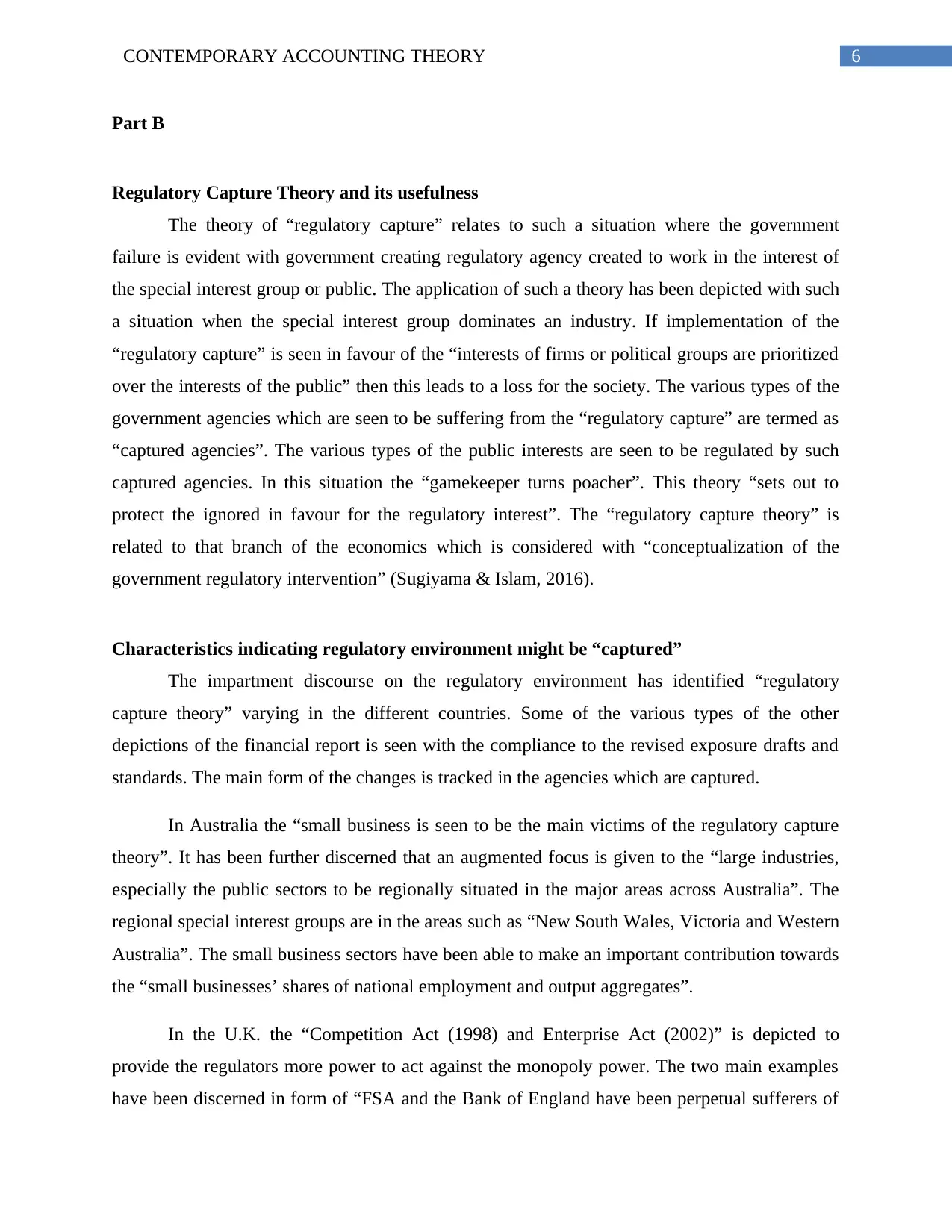
6CONTEMPORARY ACCOUNTING THEORY
Part B
Regulatory Capture Theory and its usefulness
The theory of “regulatory capture” relates to such a situation where the government
failure is evident with government creating regulatory agency created to work in the interest of
the special interest group or public. The application of such a theory has been depicted with such
a situation when the special interest group dominates an industry. If implementation of the
“regulatory capture” is seen in favour of the “interests of firms or political groups are prioritized
over the interests of the public” then this leads to a loss for the society. The various types of the
government agencies which are seen to be suffering from the “regulatory capture” are termed as
“captured agencies”. The various types of the public interests are seen to be regulated by such
captured agencies. In this situation the “gamekeeper turns poacher”. This theory “sets out to
protect the ignored in favour for the regulatory interest”. The “regulatory capture theory” is
related to that branch of the economics which is considered with “conceptualization of the
government regulatory intervention” (Sugiyama & Islam, 2016).
Characteristics indicating regulatory environment might be “captured”
The impartment discourse on the regulatory environment has identified “regulatory
capture theory” varying in the different countries. Some of the various types of the other
depictions of the financial report is seen with the compliance to the revised exposure drafts and
standards. The main form of the changes is tracked in the agencies which are captured.
In Australia the “small business is seen to be the main victims of the regulatory capture
theory”. It has been further discerned that an augmented focus is given to the “large industries,
especially the public sectors to be regionally situated in the major areas across Australia”. The
regional special interest groups are in the areas such as “New South Wales, Victoria and Western
Australia”. The small business sectors have been able to make an important contribution towards
the “small businesses’ shares of national employment and output aggregates”.
In the U.K. the “Competition Act (1998) and Enterprise Act (2002)” is depicted to
provide the regulators more power to act against the monopoly power. The two main examples
have been discerned in form of “FSA and the Bank of England have been perpetual sufferers of
Part B
Regulatory Capture Theory and its usefulness
The theory of “regulatory capture” relates to such a situation where the government
failure is evident with government creating regulatory agency created to work in the interest of
the special interest group or public. The application of such a theory has been depicted with such
a situation when the special interest group dominates an industry. If implementation of the
“regulatory capture” is seen in favour of the “interests of firms or political groups are prioritized
over the interests of the public” then this leads to a loss for the society. The various types of the
government agencies which are seen to be suffering from the “regulatory capture” are termed as
“captured agencies”. The various types of the public interests are seen to be regulated by such
captured agencies. In this situation the “gamekeeper turns poacher”. This theory “sets out to
protect the ignored in favour for the regulatory interest”. The “regulatory capture theory” is
related to that branch of the economics which is considered with “conceptualization of the
government regulatory intervention” (Sugiyama & Islam, 2016).
Characteristics indicating regulatory environment might be “captured”
The impartment discourse on the regulatory environment has identified “regulatory
capture theory” varying in the different countries. Some of the various types of the other
depictions of the financial report is seen with the compliance to the revised exposure drafts and
standards. The main form of the changes is tracked in the agencies which are captured.
In Australia the “small business is seen to be the main victims of the regulatory capture
theory”. It has been further discerned that an augmented focus is given to the “large industries,
especially the public sectors to be regionally situated in the major areas across Australia”. The
regional special interest groups are in the areas such as “New South Wales, Victoria and Western
Australia”. The small business sectors have been able to make an important contribution towards
the “small businesses’ shares of national employment and output aggregates”.
In the U.K. the “Competition Act (1998) and Enterprise Act (2002)” is depicted to
provide the regulators more power to act against the monopoly power. The two main examples
have been discerned in form of “FSA and the Bank of England have been perpetual sufferers of
Paraphrase This Document
Need a fresh take? Get an instant paraphrase of this document with our AI Paraphraser
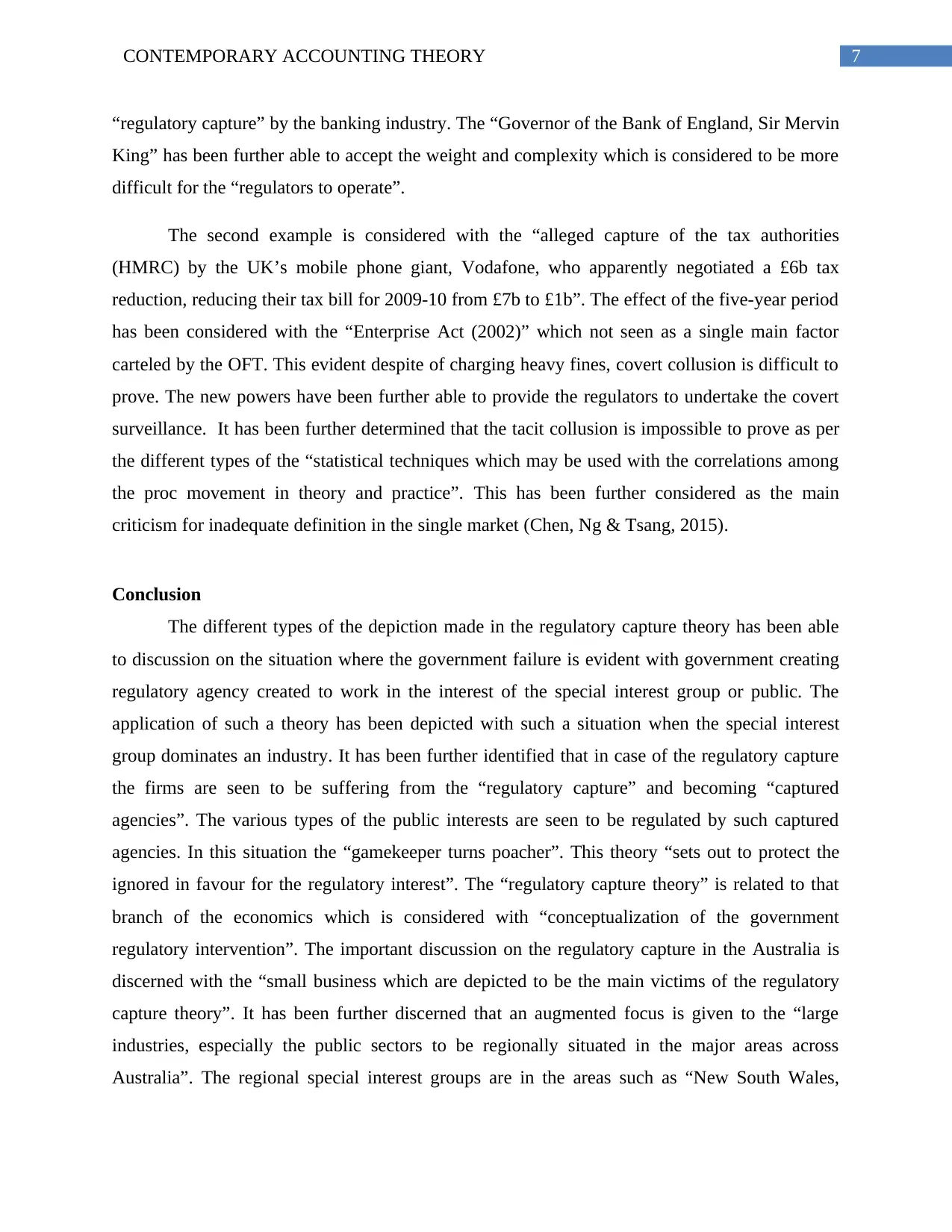
7CONTEMPORARY ACCOUNTING THEORY
“regulatory capture” by the banking industry. The “Governor of the Bank of England, Sir Mervin
King” has been further able to accept the weight and complexity which is considered to be more
difficult for the “regulators to operate”.
The second example is considered with the “alleged capture of the tax authorities
(HMRC) by the UK’s mobile phone giant, Vodafone, who apparently negotiated a £6b tax
reduction, reducing their tax bill for 2009-10 from £7b to £1b”. The effect of the five-year period
has been considered with the “Enterprise Act (2002)” which not seen as a single main factor
carteled by the OFT. This evident despite of charging heavy fines, covert collusion is difficult to
prove. The new powers have been further able to provide the regulators to undertake the covert
surveillance. It has been further determined that the tacit collusion is impossible to prove as per
the different types of the “statistical techniques which may be used with the correlations among
the proc movement in theory and practice”. This has been further considered as the main
criticism for inadequate definition in the single market (Chen, Ng & Tsang, 2015).
Conclusion
The different types of the depiction made in the regulatory capture theory has been able
to discussion on the situation where the government failure is evident with government creating
regulatory agency created to work in the interest of the special interest group or public. The
application of such a theory has been depicted with such a situation when the special interest
group dominates an industry. It has been further identified that in case of the regulatory capture
the firms are seen to be suffering from the “regulatory capture” and becoming “captured
agencies”. The various types of the public interests are seen to be regulated by such captured
agencies. In this situation the “gamekeeper turns poacher”. This theory “sets out to protect the
ignored in favour for the regulatory interest”. The “regulatory capture theory” is related to that
branch of the economics which is considered with “conceptualization of the government
regulatory intervention”. The important discussion on the regulatory capture in the Australia is
discerned with the “small business which are depicted to be the main victims of the regulatory
capture theory”. It has been further discerned that an augmented focus is given to the “large
industries, especially the public sectors to be regionally situated in the major areas across
Australia”. The regional special interest groups are in the areas such as “New South Wales,
“regulatory capture” by the banking industry. The “Governor of the Bank of England, Sir Mervin
King” has been further able to accept the weight and complexity which is considered to be more
difficult for the “regulators to operate”.
The second example is considered with the “alleged capture of the tax authorities
(HMRC) by the UK’s mobile phone giant, Vodafone, who apparently negotiated a £6b tax
reduction, reducing their tax bill for 2009-10 from £7b to £1b”. The effect of the five-year period
has been considered with the “Enterprise Act (2002)” which not seen as a single main factor
carteled by the OFT. This evident despite of charging heavy fines, covert collusion is difficult to
prove. The new powers have been further able to provide the regulators to undertake the covert
surveillance. It has been further determined that the tacit collusion is impossible to prove as per
the different types of the “statistical techniques which may be used with the correlations among
the proc movement in theory and practice”. This has been further considered as the main
criticism for inadequate definition in the single market (Chen, Ng & Tsang, 2015).
Conclusion
The different types of the depiction made in the regulatory capture theory has been able
to discussion on the situation where the government failure is evident with government creating
regulatory agency created to work in the interest of the special interest group or public. The
application of such a theory has been depicted with such a situation when the special interest
group dominates an industry. It has been further identified that in case of the regulatory capture
the firms are seen to be suffering from the “regulatory capture” and becoming “captured
agencies”. The various types of the public interests are seen to be regulated by such captured
agencies. In this situation the “gamekeeper turns poacher”. This theory “sets out to protect the
ignored in favour for the regulatory interest”. The “regulatory capture theory” is related to that
branch of the economics which is considered with “conceptualization of the government
regulatory intervention”. The important discussion on the regulatory capture in the Australia is
discerned with the “small business which are depicted to be the main victims of the regulatory
capture theory”. It has been further discerned that an augmented focus is given to the “large
industries, especially the public sectors to be regionally situated in the major areas across
Australia”. The regional special interest groups are in the areas such as “New South Wales,
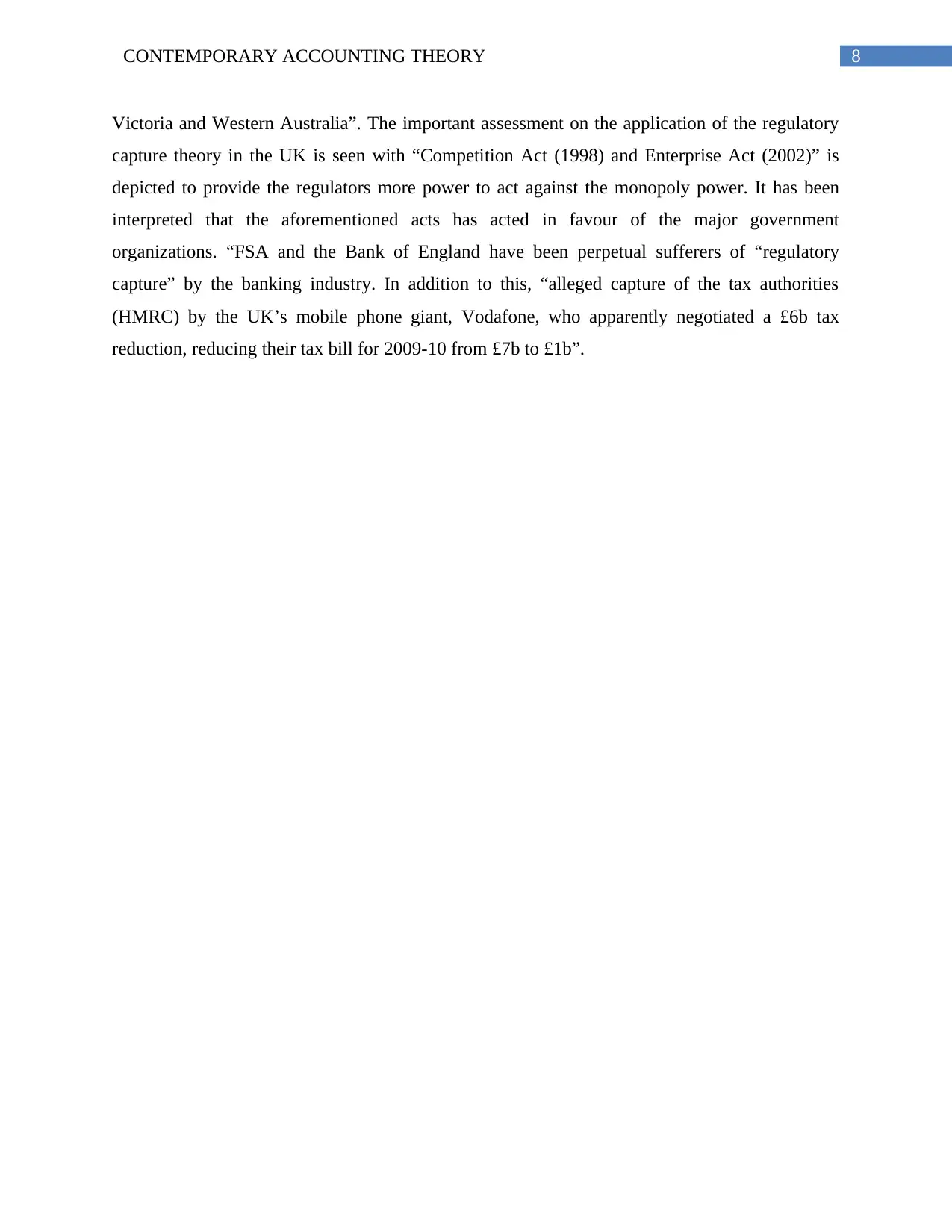
8CONTEMPORARY ACCOUNTING THEORY
Victoria and Western Australia”. The important assessment on the application of the regulatory
capture theory in the UK is seen with “Competition Act (1998) and Enterprise Act (2002)” is
depicted to provide the regulators more power to act against the monopoly power. It has been
interpreted that the aforementioned acts has acted in favour of the major government
organizations. “FSA and the Bank of England have been perpetual sufferers of “regulatory
capture” by the banking industry. In addition to this, “alleged capture of the tax authorities
(HMRC) by the UK’s mobile phone giant, Vodafone, who apparently negotiated a £6b tax
reduction, reducing their tax bill for 2009-10 from £7b to £1b”.
Victoria and Western Australia”. The important assessment on the application of the regulatory
capture theory in the UK is seen with “Competition Act (1998) and Enterprise Act (2002)” is
depicted to provide the regulators more power to act against the monopoly power. It has been
interpreted that the aforementioned acts has acted in favour of the major government
organizations. “FSA and the Bank of England have been perpetual sufferers of “regulatory
capture” by the banking industry. In addition to this, “alleged capture of the tax authorities
(HMRC) by the UK’s mobile phone giant, Vodafone, who apparently negotiated a £6b tax
reduction, reducing their tax bill for 2009-10 from £7b to £1b”.
⊘ This is a preview!⊘
Do you want full access?
Subscribe today to unlock all pages.

Trusted by 1+ million students worldwide
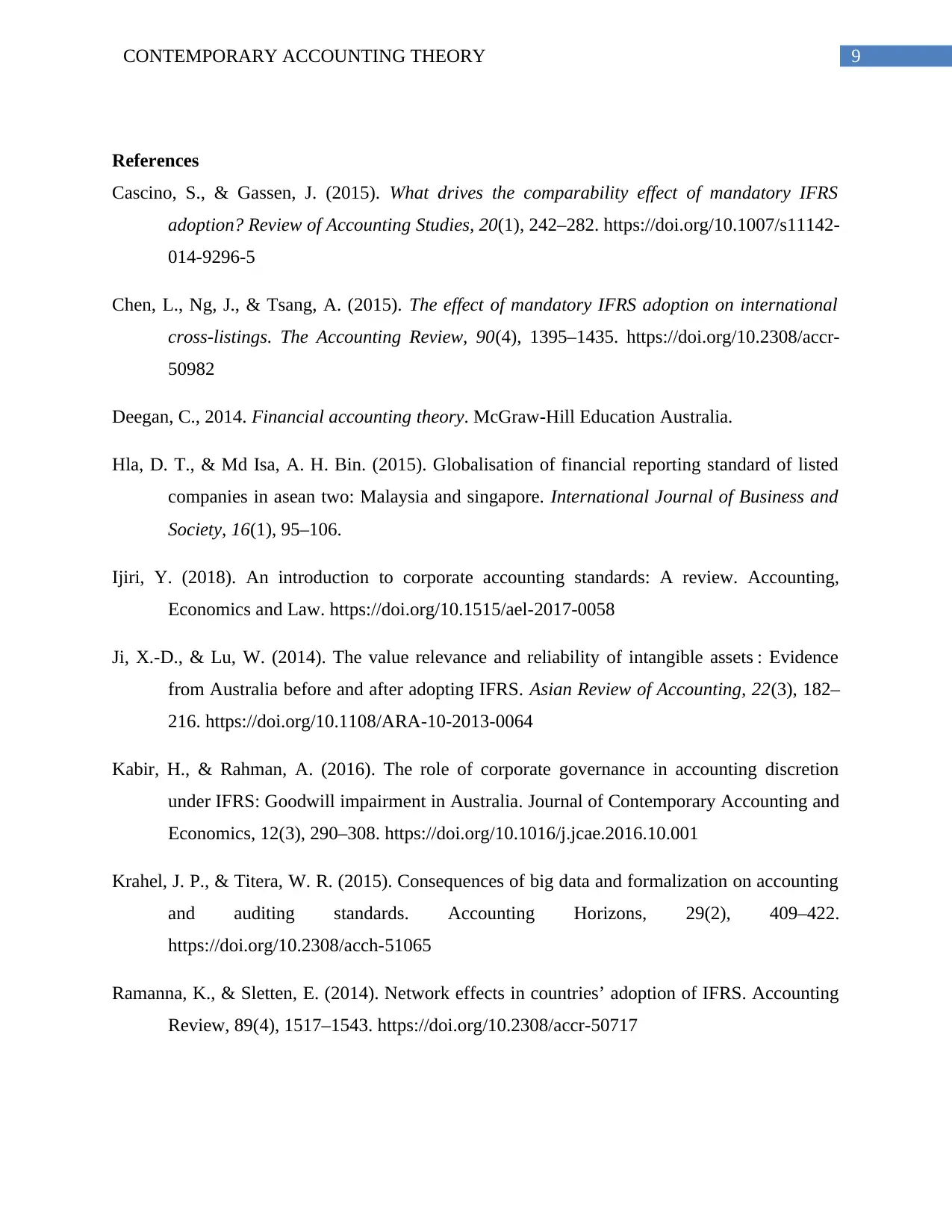
9CONTEMPORARY ACCOUNTING THEORY
References
Cascino, S., & Gassen, J. (2015). What drives the comparability effect of mandatory IFRS
adoption? Review of Accounting Studies, 20(1), 242–282. https://doi.org/10.1007/s11142-
014-9296-5
Chen, L., Ng, J., & Tsang, A. (2015). The effect of mandatory IFRS adoption on international
cross-listings. The Accounting Review, 90(4), 1395–1435. https://doi.org/10.2308/accr-
50982
Deegan, C., 2014. Financial accounting theory. McGraw-Hill Education Australia.
Hla, D. T., & Md Isa, A. H. Bin. (2015). Globalisation of financial reporting standard of listed
companies in asean two: Malaysia and singapore. International Journal of Business and
Society, 16(1), 95–106.
Ijiri, Y. (2018). An introduction to corporate accounting standards: A review. Accounting,
Economics and Law. https://doi.org/10.1515/ael-2017-0058
Ji, X.-D., & Lu, W. (2014). The value relevance and reliability of intangible assets : Evidence
from Australia before and after adopting IFRS. Asian Review of Accounting, 22(3), 182–
216. https://doi.org/10.1108/ARA-10-2013-0064
Kabir, H., & Rahman, A. (2016). The role of corporate governance in accounting discretion
under IFRS: Goodwill impairment in Australia. Journal of Contemporary Accounting and
Economics, 12(3), 290–308. https://doi.org/10.1016/j.jcae.2016.10.001
Krahel, J. P., & Titera, W. R. (2015). Consequences of big data and formalization on accounting
and auditing standards. Accounting Horizons, 29(2), 409–422.
https://doi.org/10.2308/acch-51065
Ramanna, K., & Sletten, E. (2014). Network effects in countries’ adoption of IFRS. Accounting
Review, 89(4), 1517–1543. https://doi.org/10.2308/accr-50717
References
Cascino, S., & Gassen, J. (2015). What drives the comparability effect of mandatory IFRS
adoption? Review of Accounting Studies, 20(1), 242–282. https://doi.org/10.1007/s11142-
014-9296-5
Chen, L., Ng, J., & Tsang, A. (2015). The effect of mandatory IFRS adoption on international
cross-listings. The Accounting Review, 90(4), 1395–1435. https://doi.org/10.2308/accr-
50982
Deegan, C., 2014. Financial accounting theory. McGraw-Hill Education Australia.
Hla, D. T., & Md Isa, A. H. Bin. (2015). Globalisation of financial reporting standard of listed
companies in asean two: Malaysia and singapore. International Journal of Business and
Society, 16(1), 95–106.
Ijiri, Y. (2018). An introduction to corporate accounting standards: A review. Accounting,
Economics and Law. https://doi.org/10.1515/ael-2017-0058
Ji, X.-D., & Lu, W. (2014). The value relevance and reliability of intangible assets : Evidence
from Australia before and after adopting IFRS. Asian Review of Accounting, 22(3), 182–
216. https://doi.org/10.1108/ARA-10-2013-0064
Kabir, H., & Rahman, A. (2016). The role of corporate governance in accounting discretion
under IFRS: Goodwill impairment in Australia. Journal of Contemporary Accounting and
Economics, 12(3), 290–308. https://doi.org/10.1016/j.jcae.2016.10.001
Krahel, J. P., & Titera, W. R. (2015). Consequences of big data and formalization on accounting
and auditing standards. Accounting Horizons, 29(2), 409–422.
https://doi.org/10.2308/acch-51065
Ramanna, K., & Sletten, E. (2014). Network effects in countries’ adoption of IFRS. Accounting
Review, 89(4), 1517–1543. https://doi.org/10.2308/accr-50717
Paraphrase This Document
Need a fresh take? Get an instant paraphrase of this document with our AI Paraphraser

10CONTEMPORARY ACCOUNTING THEORY
Sugiyama, S., & Islam, J. (2016). Empirical findings from the reconciliations in the first IFRS
compliant reports prepared by Japanese-owned subsidiaries in Australia. Advances in
Accounting, 35, 143–158. https://doi.org/10.1016/j.adiac.2016.06.003
Sugiyama, S., & Islam, J. (2016). Empirical findings from the reconciliations in the first IFRS
compliant reports prepared by Japanese-owned subsidiaries in Australia. Advances in
Accounting, 35, 143–158. https://doi.org/10.1016/j.adiac.2016.06.003
1 out of 11
Related Documents
Your All-in-One AI-Powered Toolkit for Academic Success.
+13062052269
info@desklib.com
Available 24*7 on WhatsApp / Email
![[object Object]](/_next/static/media/star-bottom.7253800d.svg)
Unlock your academic potential
Copyright © 2020–2025 A2Z Services. All Rights Reserved. Developed and managed by ZUCOL.



